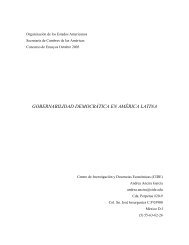The Road to Hemispheric Cooperation: Beyond the Cartagena
The Road to Hemispheric Cooperation: Beyond the Cartagena
The Road to Hemispheric Cooperation: Beyond the Cartagena
Create successful ePaper yourself
Turn your PDF publications into a flip-book with our unique Google optimized e-Paper software.
operations by transnational syndicates <strong>to</strong> encompass <strong>the</strong><br />
presence of local illicit markets involving myriad criminal<br />
activities. Colombia and Mexico’s security situation, while<br />
still heavily determined by <strong>the</strong> intensity of organized crime,<br />
presents unique traits. After many years of combating drug<br />
trafficking and crime, <strong>the</strong> overall results are mixed. Good<br />
security-enhancing strategies at <strong>the</strong> national and some local<br />
levels, and lower homicide rates overall, coexist with<br />
<strong>the</strong> visible presence of organized crime and armed groups,<br />
which are linked <strong>to</strong> cocaine production and trafficking. In<br />
Venezuela, <strong>the</strong> politicization and subsequent collapse of<br />
law enforcement institutions, <strong>the</strong> systematic weakening of<br />
local authorities, and <strong>the</strong> country’s increased transshipment<br />
role in <strong>the</strong> narcotics trade have created a lethal cocktail<br />
that is pushing crime rates upward.<br />
Meanwhile, in most Andean countries (Peru, Bolivia and<br />
Ecuador) <strong>the</strong> main problem is increasingly violent street<br />
crime. <strong>The</strong>re is no clear evidence <strong>to</strong> link this problem <strong>to</strong><br />
drug trafficking (internal or external) and that may help <strong>to</strong><br />
explain why murder rates remain moderate. <strong>The</strong> public<br />
safety problems faced by Argentina, Chile and Uruguay, in<br />
turn, are related <strong>to</strong> highly localized spaces where levels of<br />
violence are high, as well as <strong>the</strong> growing incidence of property<br />
and personal crime linked <strong>to</strong> small, local organizations<br />
ra<strong>the</strong>r than transnational crime syndicates.<br />
<strong>The</strong> point <strong>to</strong> emphasize here is that, while an important<br />
concern, transnational drug trafficking is merely one fac<strong>to</strong>r<br />
in explaining <strong>the</strong> levels of violence in <strong>the</strong> region. Fighting<br />
international drug trafficking ought not <strong>to</strong> be turned in<strong>to</strong> <strong>the</strong><br />
articulating principle of a hemispheric public safety agenda.<br />
Even in countries where it is a major determinant of<br />
crime rates, <strong>the</strong> pervasive presence of <strong>the</strong> narcotics trade<br />
compounds and indeed builds upon a plethora of deeper<br />
structural fac<strong>to</strong>rs that enhance <strong>the</strong> vulnerability of <strong>the</strong>se<br />
countries <strong>to</strong> organized crime. Among o<strong>the</strong>rs, <strong>the</strong>se fac<strong>to</strong>rs<br />
include: weak state institutions unable <strong>to</strong> command a strong<br />
presence in <strong>the</strong> terri<strong>to</strong>ry and offer adequate access <strong>to</strong> public<br />
services; vastly inadequate law enforcement capabilities;<br />
high levels of political and institutional corruption; marginalization<br />
of a significant proportion of <strong>the</strong> young population,<br />
<strong>the</strong>reby creating a reserve army for illegal activities; growing<br />
levels of internal drug consumption; and limited and<br />
ineffective gun control policies. <strong>The</strong> construction of safer<br />
societies in <strong>the</strong> hemisphere requires paying attention <strong>to</strong><br />
all <strong>the</strong>se fac<strong>to</strong>rs, most of which are not amenable <strong>to</strong> quick<br />
fixes. In particular, it is worth insisting that public insecurity<br />
cannot be separated from social exclusion.<br />
<strong>The</strong> main challenge, <strong>the</strong>refore, is <strong>to</strong> put in place comprehensive<br />
approaches <strong>to</strong> deal with public safety issues in several<br />
complementary ways. <strong>The</strong>y range from institution-building<br />
initiatives particularly focused on police, justice reform and<br />
prison systems, <strong>to</strong> social policies aimed at changing <strong>the</strong><br />
conditions under which crime activities have flourished. Try<br />
as hard as it may, <strong>the</strong> world’s most inequitable region will<br />
not be able <strong>to</strong> defeat criminal violence by relying on lawand-order<br />
policies alone. Improving human development<br />
and social inclusion are a key part of <strong>the</strong> solution.<br />
<strong>The</strong> <strong>Hemispheric</strong> Opportunity<br />
Public security challenges are a cloud hovering over <strong>the</strong><br />
consolidation of democracy in <strong>the</strong> Western Hemisphere.<br />
Confronting public insecurity in <strong>the</strong> hemisphere demands<br />
efforts at <strong>the</strong> local, national, regional and hemispheric levels.<br />
<strong>The</strong>se efforts should include <strong>the</strong> fight against transnational<br />
drug trafficking as an important element, but not<br />
<strong>the</strong> backbone of <strong>the</strong> strategy. An international cooperation<br />
agenda that focuses on tackling structural fac<strong>to</strong>rs that generate<br />
and reproduce criminal violence, ra<strong>the</strong>r than simply<br />
on controlling crime, is essential.<br />
<strong>The</strong> following areas are particularly ripe for policy intervention<br />
and cooperation at <strong>the</strong> hemispheric level:<br />
●● Reframing <strong>the</strong> discussion. This means resisting appeals<br />
<strong>to</strong> fighting crime through iron-fisted methods that<br />
almost always fail <strong>to</strong> reduce crime rates but never fail <strong>to</strong><br />
undermine basic civil rights. <strong>The</strong> only sustainable way<br />
<strong>to</strong> succeed in <strong>the</strong> struggle against crime involves implementing<br />
effective strategies for social prevention and<br />
deepening our countries’ commitment <strong>to</strong> fur<strong>the</strong>ring human<br />
development, reducing inequality, and expanding<br />
<strong>the</strong> opportunities available <strong>to</strong> young people. However,<br />
social prevention must be calibrated with <strong>the</strong> strong<br />
sense of urgency that <strong>the</strong> situation demands and by <strong>the</strong><br />
recognition that state coercion, within <strong>the</strong> boundaries of<br />
<strong>the</strong> rule of law, is unavoidable in <strong>the</strong> fight against crime.<br />
This is particularly true in responding <strong>to</strong> organized crime,<br />
which demands less social prevention and greater use<br />
of intelligence efforts and coercion. Moreover, effective<br />
<strong>The</strong> <strong>Road</strong> <strong>to</strong> <strong>Hemispheric</strong> <strong>Cooperation</strong>: <strong>Beyond</strong> <strong>the</strong> <strong>Cartagena</strong> Summit of <strong>the</strong> Americas<br />
<strong>The</strong> Brookings Institution ❘ Latin America Initiative<br />
69








